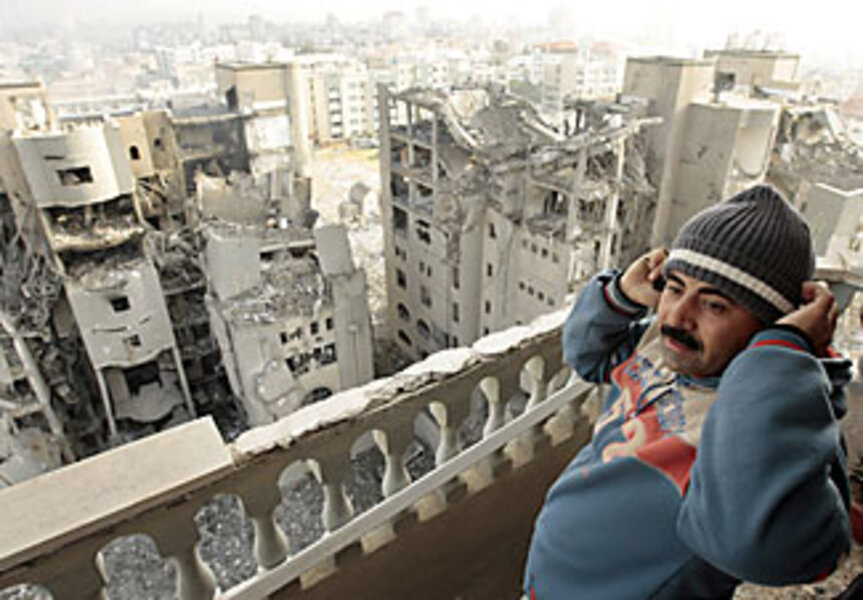Gazan civilians increasingly at risk in assault on Hamas
Loading...
| Tel Aviv
On the fourth day of airstrikes in Gaza Tuesday, one of Israel's many targets was a Hamas military commander's home within the teeming Jabaliya refugee camp. He wasn't there, but seven civilians died as a result of that attack.
Until now Israel has targeted mainly Hamas offices, ministries, and centers of power in a bid to limit collateral damage while still crippling the Islamists' ability to fire rockets across the border. But as the conflict stretches on and Israeli warplanes and drones seek out Hamas commanders and other militant leaders hiding in neighborhoods in the densely packed coastal strip, it will be harder to contain civilian deaths.
So far Israel has been relatively successful at zeroing in on targets and avoiding civilian casualties. It has run 400 sorties since the start of the conflict Saturday in an enclave about twice the size of Washington, D.C. Of the more than 370 Palestinians killed, at least 64 have been civilians, according to the United Nations.
Israeli military tacticians are all too aware that if civilian casualties climb too high, international pressure can end an otherwise carefully executed attack. It happened in the 2006 Lebanon war when Israel's allies could no longer tolerate the loss of innocent life. It's a metric that is callous yet at the forefront of modern Middle Eastern warfare.
"The more Israel's enemies are non state actors like Hamas, the more warfare has changed. The name of the game in warfare now is how to win the urban war, and that creates a whole new set of challenges," says David Makovsky, a fellow at the Washington Institute.
"Israel is always going to try to thread the needle, to hit those that hit them, but to try to avoid the loss of civilian life," he says.
Military experts dryly call it "collateral damage," a term referring to injured bystanders or property uninvolved in combat. Human rights advocates counter that the concept sanitizes the unavoidable costs of war.
Because Israel no longer faces conventional forces but smaller guerrilla armies in civilian areas, the mismatched fight has altered the nature of battle. The challenges are similar to those faced by the US in Iraq and Afghanistan.
On Tuesday morning, Palestinians reported that two young sisters from the Gazan farming village of Beit Hanoun were killed in one of the Israel air attacks – an example of just the kind of "collateral damage" that can turn the tables on the military and shorten a campaign.
An Israeli army spokeswoman said that the military is looking into the report, noting that the army tries to avoid civilian casualties.
Hamas says that it has fired more than 250 rockets and mortars on Israel since the offensive began and Israel reports that 40 were fired Tuesday. Three Israeli civilians and one soldier have been killed so far in rocket fire from Gaza militants.
Minimizing civilian casualties in Gaza requires "a combination of excellent intelligence, very accurate weapons systems, and very good planning that takes into account collateral damage," says Shlomo Brom, a former brigadier general who headed the Israeli army's strategic planning division.
Military planners rely on systems that integrate electro-optical, laser-guided, and global positioning technology, he says. So far, "the air operations are brilliant," but, he added, "mistakes are bound to happen and they will happen in this war."
Just such a mistake occurred in the third week of Israel's 2006 battle with Hezbollah in Lebanon, when the Israeli air force bombed a three-story building in the village of Qana and killed dozens of people, mostly children.
Described as an Israeli "massacre" by the Lebanese, the attack ratcheted up pressure for a cease-fire and became part of the well-orchestrated Hezbollah propaganda campaign that accompanied its fight with Israel. Israel was also accused of targeting civilians by using cluster bombs in the final days of the war even though Israel says it used them in accordance with international law.
Human Rights Watch, however, charges that Israel breached prohibitions by dropping cluster bombs in a civilian area.
In Gaza six years ago, the air force was accused of knowingly targeting civilians when it dropped a one-ton bomb on the hideout of Salah Shahade, a Hamas commander. The blast killed 15 civilians, including Mr. Shahde's wife and nine children.
"They are not intending to kill civilians, I believe that," says Iyad Sarraj, a Gazan human rights activist who heads the Gaza Community Mental Health Center. "But at the same time, if they have a target, and some civilians are in the vicinity, it doesn't matter. They have to hit the target anyway. Add to this that they are not 100 percent accurate."
Mr. Sarraj says that a friend and his family were almost left for dead after their house was buried in the rubble from an the Israeli air force attack on a neighboring multistory building.
To be sure, the debate over civilian casualties is littered with political, moral, and emotional land mines. Israelis claim the high ground by arguing that even though they fight terrorists who deliberately target civilians, they try to uphold a spirit of "purity of arms" by avoiding civilian casualties as much as possible.
Critics counter that by putting Palestinian towns under blockade and going after militants in civilian areas, Israel makes noncombantants targets.
For Ziad Koraz, whose nearby home was damaged in the attack on the government compound Tuesday, that violence gratuitously puts Gazan civilians at risk, the Associated Press reported.
"More than 17 missiles were directed at an empty government compound, without regard for civilians who lived nearby," Mr. Koraz said. "If someone committed a crime, they should go after him, not after an entire nation."





